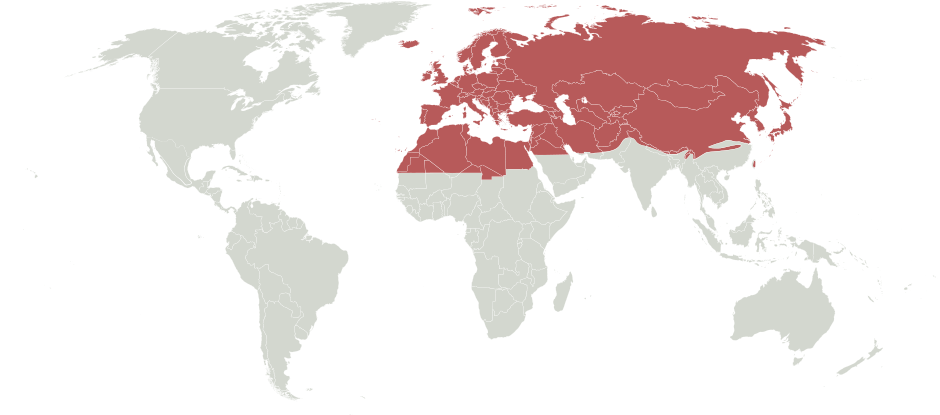Family: Megachilidae
Subfamily: Megachilinae
Tribe: Osmiini
Genus: Stenoheriades Tkalců, 1984
Subgenera: none
Common name: none
Stenoheriades are coarsely punctatepunctate:
studded with tiny holes
, black bees with white hair bandsbands:
usually referring to bands of hair or bands of color that traverse across an abdominal segment
on their tergaterga:
the segments on the top side of the abdomen, often abbreviated when referring to a specific segment to T1, T2, T3, T4, T5, T6, or T7 and a slender, elongate build. They range in body length from 5–7 mm (Michener 2007Michener 2007:
and a slender, elongate build. They range in body length from 5–7 mm (Michener 2007Michener 2007:
Michener, C.D. 2007. The Bees of the World (2nd ed.). Johns Hopkins University Press, Baltimore and London, 953 pp.).
Stenoheriades contains 11 described species and 6 undescribed species worldwide; none are known to occur in the U.S. or Canada (Michener 2007Michener 2007:
Michener, C.D. 2007. The Bees of the World (2nd ed.). Johns Hopkins University Press, Baltimore and London, 953 pp.; Müller and Trunz 2014; Griswold 2018Griswold 2018:
Griswold, T.L. 2018. First record of Stenoheriades Cockerell in tropical Asia: Stenoheriades bifida , new species (Hymenoptera: Megachilidae). Zootaxa 4370: 279ndash;282.;). Despite the small number of species, Stenoheriades is very diverse in form; there are four species groups that are as distinct as subgenera in other osmiine genera (Griswold 1985Griswold 1985:
Griswold, T. 1985. A generic and subgeneric revision of the Heriades genus-group. Logan: Ph.D. thesis, Utah State University. xiii + 165 pp.).
(modified from Michener 2007Michener 2007:
Michener, C.D. 2007. The Bees of the World (2nd ed.). Johns Hopkins University Press, Baltimore and London, 953 pp.)
 with crenulatecrenulate:
with crenulatecrenulate: apicallyapically:
apicallyapically:Stenoheriades may be confused with Heriades due to a similar elongate build and coloration. However, Stenoheriades males lack the dentate preapicalpreapical:
referring to a section of a bee that is physically found just before the outermost (or apical) end of the section or segment
ridge on T6T6:
the segments on the top side of the abdomen, often abbreviated when referring to a specific segment to T1, T2, T3, T4, T5, T6, or T7 , and T7T7:
, and T7T7:
the segments on the top side of the abdomen, often abbreviated when referring to a specific segment to T1, T2, T3, T4, T5, T6, or T7 is not visible. Female Stenoheriades have a shorter proboscisproboscis:
is not visible. Female Stenoheriades have a shorter proboscisproboscis:
an elongated sucking mouthpart that is typically tubular and flexible
, which is not produced beyond the fossafossa:
the large, deep groove on the underside of the head into which the proboscis folds
(Michener 2007Michener 2007:
Michener, C.D. 2007. The Bees of the World (2nd ed.). Johns Hopkins University Press, Baltimore and London, 953 pp.).
There are no known invasives.
Stenoheriades appear to exhibit varying levels of host specialization on Asteraceae (Müller and Trunz 2014). Some species are narrowly specialized on Anthemis, such as S. asiatica and S. coelostoma, whereas others (S. eingeddicus) visit Aster (Müller and Trunz 2014). Some species appear to be less specialized, such as S. marocanna which more broadly visits Cichoriodea (Müller and Trunz 2014).
Stenoheriades are widespread in the Afrotropical and western PalearcticPalearctic:
the largest biogeographic region; consists of Europe, Asia north of the Himalaya foothills, Northern Africa, and the northern and central parts of the Arabian Peninsula regions (Michener 2007Michener 2007:
regions (Michener 2007Michener 2007:
Michener, C.D. 2007. The Bees of the World (2nd ed.). Johns Hopkins University Press, Baltimore and London, 953 pp.). Although rare, their range is broad, encompassing southern Europe in southern Spain and Sicily, southeastern Europe in Bulgaria and Croatia, Turkey, the Arabian Peninsula, Morocco, sub-Saharan Africa to South Africa, and Madagascar (Michener 2007Michener 2007:
Michener, C.D. 2007. The Bees of the World (2nd ed.). Johns Hopkins University Press, Baltimore and London, 953 pp.). One species is known to have a disjunct distribution and is found in southern India (Griswold 2018Griswold 2018:
Griswold, T.L. 2018. First record of Stenoheriades Cockerell in tropical Asia: Stenoheriades bifida , new species (Hymenoptera: Megachilidae). Zootaxa 4370: 279ndash;282.). Six undescribed species occur in the Afrotropical region (Michener 2007Michener 2007:
Michener, C.D. 2007. The Bees of the World (2nd ed.). Johns Hopkins University Press, Baltimore and London, 953 pp.).
Distribution map generated by Discover Life -- click on map for details, credits, and terms of use.
Griswold, T.L. 1985. A generic and subgeneric revision of the Heriades genus-group (Hymenoptera: Megachilidae). Doctoral dissertation, Utah State University, Department of Biology, 207 pp.
Griswold, T.L. 2018. First record of Stenoheriades Cockerell in tropical Asia: Stenoheriades bifida, new species (Hymenoptera: Megachilidae). Zootaxa 4370:279-282.
Michener, C.D. 2007. The Bees of the World (2nd ed.). Johns Hopkins University Press, Baltimore and London, 953 pp.
Müller, A. and V. Trunz. 2014. Palaearctic osmiine bee of the genera Hofferia and Stenoheriades (Megachilidae, Osmiini): biology, taxonomy, and key to species. Zootaxa 3765:175-186.